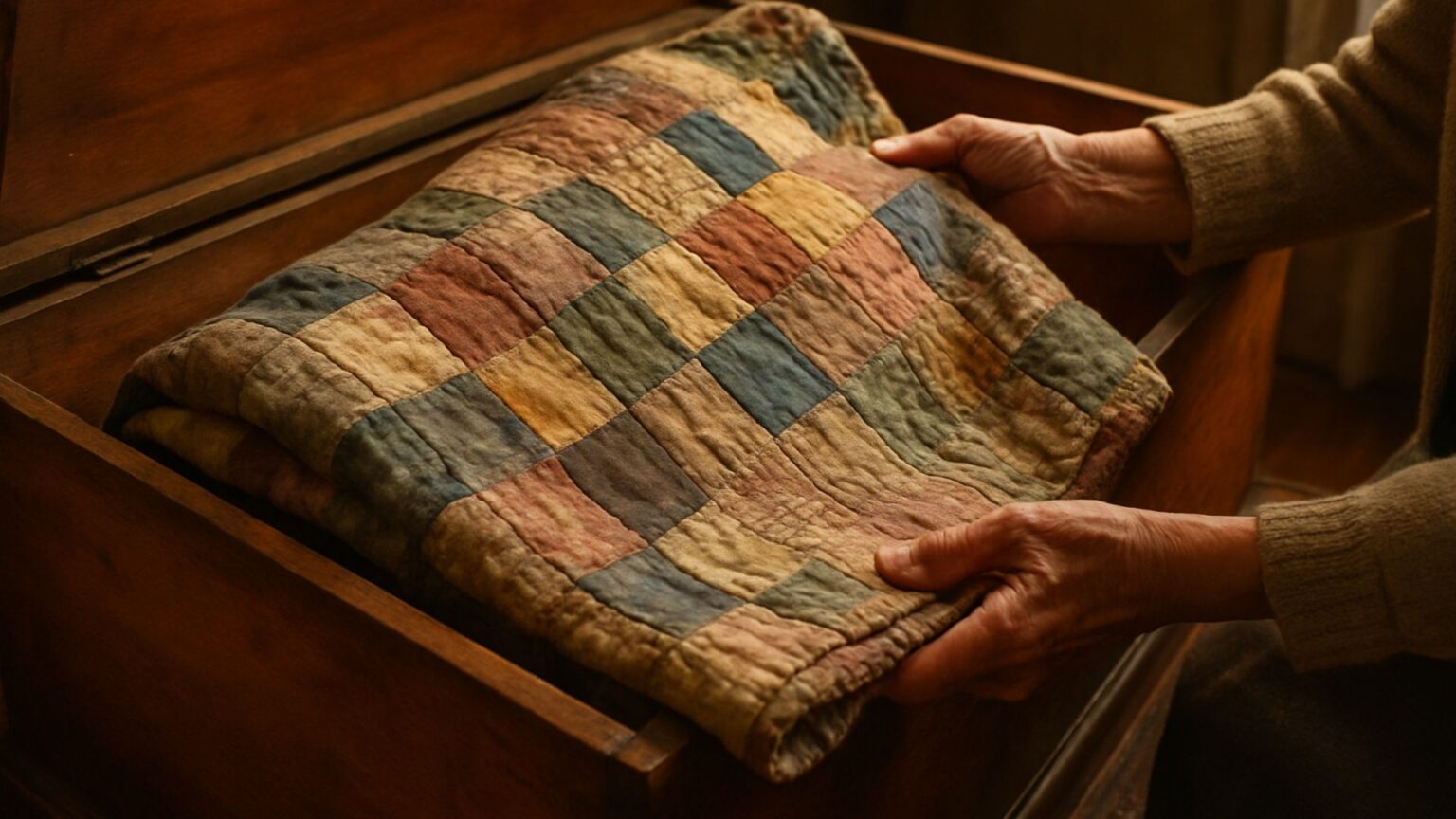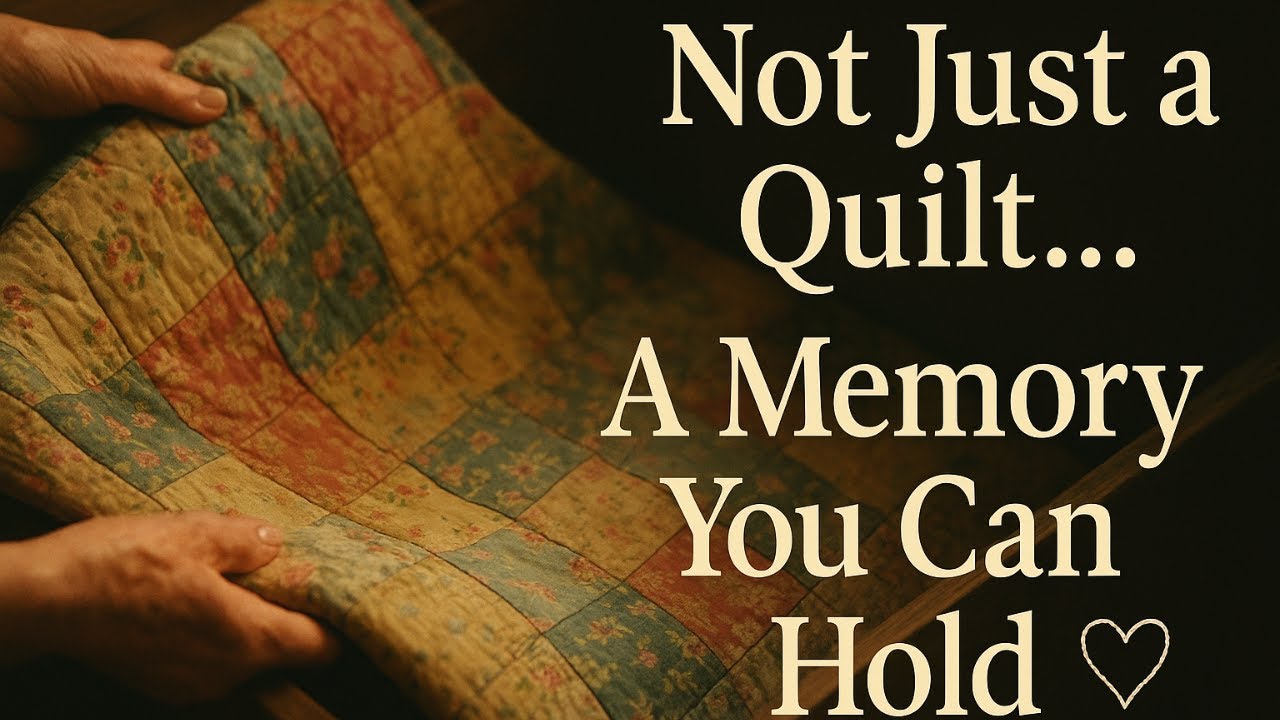Home » Patchwork Quilts: Grandma’s Art of Love and Lasting Legacy
Patchwork Quilts: Grandma’s Art of Love and Lasting Legacy

Maybe you’ve lifted patchwork quilts from a cedar chest before—one that smelled faintly of lavender, wood polish, and time. Its colors may have softened with age, the edges gently frayed from years of Sunday naps, winter chills, and stories whispered beneath it. You lift it slowly, almost afraid to unfold it too quickly, as if doing so might disturb the memories tucked between each patch.
It’s soft, not just in fabric, but in feeling—like love worn in by years of hands that knew how to care deeply. A patch from an old dress. A square from Grandpa’s flannel. A hint of faded floral that once wrapped a newborn tight. With every fold, it becomes clear: this quilt wasn’t made just to keep someone warm. It was made to keep someone remembered.
It was never just sewn—it was lived in.
Every patch carries a story, every stitch remembers a name.
That’s when it hits you: this isn’t about fabric at all. It’s about legacy—something rare in a world obsessed with fast, cheap, and easily replaced. And suddenly, you don’t just remember the quilt…
You miss the feeling of belonging to something handmade, something that mattered.
Maybe—just maybe—it’s time to bring that feeling back into your home again.
Patchwork Quilts: What They Are (And Why They’re More Than Just Fabric)
A patchwork quilt might look simple at first glance—just a collection of fabric pieces stitched together in repeated patterns or patchy blocks. But in truth, it’s so much more than leftover cloth. Traditionally, patchwork quilts were born out of necessity. Families reused scraps from worn-out clothing, aprons, and hand-me-down dresses to create warmth using what they had. Every patch came with a story—maybe from a child’s first school dress, a father’s favorite flannel, or a Sunday best that no longer fit.
Unlike mass-produced blankets made by machines, patchwork quilts were put together slowly and carefully, with human intention in every stitch. They weren’t just assembled—they were built with heart.
When someone slept beneath a patchwork quilt, they weren’t just staying warm. They were wrapped in the lives of those who came before them—held close by a legacy only fabric could remember.
Today, patchwork quilts continue to be cherished not just for comfort, but for character. They’re a symbol of care, patience, and the belief that small pieces—when thoughtfully connected—can create something beautiful enough to last generations.
Why Patchwork Quilts Still Matter in a Fast-Paced World
Patchwork quilts are more than cozy bed coverings — they are storytellers stitched in fabric. In fact, each quilt square often represents a meaningful moment from the past, whether it came from a beloved shirt, a worn dress, or a child’s favorite blanket. Moreover, unlike mass-produced textiles, patchwork quilts carry the warmth of intentional craftsmanship and emotional memory. As a result, they continue to resonate with people who long for comfort, connection, and a sense of heritage in today’s fast-paced world.

A Heritage Stitched by Hand—The History of Patchwork Quilting
Patchwork quilting didn’t start as an art form—it began as survival. In early American homes, especially during the 1800s and through the Great Depression, fabric was precious. Women gathered every usable scrap to create something warm and durable for their families. Over time, quilting became more than just a necessity—it became a shared act of community, a creative escape, and a storytelling tradition.
Quilting bees became social events, where neighbors came together not just to sew but to talk, laugh, and share life. A finished quilt was often gifted as a wedding present, passed to new brides as a symbol of warmth and hope. Soldiers carried small quilts as tokens from home during wartime. Memory quilts were stitched from worn garments of loved ones who had passed—allowing their presence to remain woven into daily life.
Many quilts were intentionally made to tell a story—marking moments like births, anniversaries, hardships, and victories. They became personal history books, preserved not in words, but in fabric.
To own or inherit a patchwork quilt was to inherit part of a legacy—proof that love could be sewn into something that endures.
Every Stitch Tells a Story—The Meaning Behind Grandma’s Quilts
Quilts were rarely made without meaning. In fact, many grandmothers stitched quietly in the evenings, selecting fabric pieces not just for their colors but for the memories woven into them. A square of floral cotton might have come from a daughter’s Sunday dress, while a deep blue patch could have belonged to a brother’s work shirt. Therefore, each block represented a moment in time, stitched together to form something greater than the sum of its parts.
But the meaning didn’t stop at materials. The act of quilting itself was a message—of care, of presence, of time willingly invested. Because the quilter caressed each square inch, pressed her fingers along the seams, and embroidered her secret wishes into the fabric, many people think that the love she had for her quilt will remain in it even after she has passed away.
Every patch carries a story; every stitch remembers a name. That’s why sleeping under a handmade quilt often feels like being wrapped in belonging—not just comfort.
Why the Art of Patchwork Is Fading (And Why That Hurts)
As the world shifted toward convenience and instant gratification, traditional patchwork quilting began to fade. Because fast fashion now floods homes with machine-produced throws, quilts no longer seem like treasured heirlooms but rather quick seasonal accessories. As a result, entire generations have grown up without seeing a loved one sew late into the night, pouring quiet devotion into every stitch.
Plus, not many individuals are patient enough to develop a skill that demands focus, commitment, and emotional engagement. Consequently, quilting bees, once lively community gatherings filled with laughter and storytelling, have mostly disappeared. Instead, screens replaced sewing circles, and family storytelling slowly slipped into silence.
For this reason, losing patchwork quilting is not just losing a hobby—it’s losing a cultural heartbeat. When a craft rooted in memory fades, a part of heritage risks vanishing with it.
Why Patchwork Quilts Still Matter Today—Big-League Legacy You Can Hold
Even though mass-produced blankets are everywhere, patchwork quilts are making a meaningful comeback. More people are seeking authenticity, warmth, and emotional connection in their homes. For this reason, heritage-inspired décor is trending, especially pieces that tell a story and feel intentionally placed rather than randomly purchased.
By repurposing imperfect materials into something beautiful, patchwork quilts also represent strength and determination. They reflect patience in a fast world and remind us that craftsmanship never truly goes out of style. As the world grows noisier, people crave the quiet assurance of something made with love, not automated in a factory.
Moreover, when displayed on a wooden ladder, draped across a cozy armchair, or layered on a farmhouse-style bed, a quilt instantly transforms a space into a place that feels lived-in, loved, and deeply personal.
Owning a quilt is not just about decorating—it’s about carrying a legacy, one that warms more than your body. It warms your story.
How to Rediscover Patchwork Quilting in Your Home (Even If You Don’t Sew)
Even if you’ve never threaded a needle, you can still bring the spirit of patchwork quilting back into your home. In fact, there are many ways to embrace quilt culture without becoming a full-time crafter. For example, you can begin by displaying an heirloom quilt on a wall, ladder stand, or foot-of-bed fold, turning it into a statement piece with emotional depth.
Moreover, antique shops and online marketplaces such as ours often offer handcrafted quilts made by modern artisans who preserve traditional techniques. Therefore, purchasing one from a skilled maker supports the continuation of the craft while also adding soulful décor to your space.
If you’re curious about quilting but don’t know where to start, beginner patchwork kits and online tutorials can gently guide you through your first stitches. As a result, many people discover that quilting is not simply a hobby but rather a meditative experience that feels like therapy stitched with thread.
Caring for Your Heirloom Quilt (So It Lasts for Generations)
Once a quilt becomes part of your heritage story, preserving it becomes essential. However, heirloom quilts require gentle treatment to ensure they age gracefully. First, always store quilts in breathable cotton or muslin bags rather than plastic, since plastic can trap moisture and cause damage over time. Also, it’s better to lay them flat or lightly roll them than to fold them tightly, which can weaken the seams and leave lasting lines.
If you need to clean your quilt, you may either hire a professional cleaner that specializes in delicate textiles or use a light detergent and hand wash. Avoid harsh sunlight, since UV rays can fade colors and weaken fibers. As a result, proper care will help maintain both the integrity and emotional value of the quilt.
To extend a quilt’s life, some families also choose to repair frayed edges or reinforce worn patches using fabric that harmonizes with the original design. Consequently, each repair becomes a continuation of the story rather than a flaw.
🛍️ Eco-Friendly Formula Made with biodegradable ingredients – Walmart
Patchwork Quilts as Meaningful Gifts for Future Generations
In a world full of gift cards and factory-made blankets, a patchwork quilt stands out as a deeply personal and lasting present. Because quilts often mark milestones—like weddings, births, anniversaries, or even housewarmings—they become woven time capsules of love and intention.
A quilt also represents safety, comfort, and warmth when given as a present. A bride receiving a quilt is not merely given bedding—she is handed a promise of home. A child wrapped in a handcrafted quilt grows up feeling loved even when the giver is no longer there. Therefore, a quilt can become an emotional anchor that survives decades and connects generations.
Modern memory quilts constructed from baby clothing, uniforms, or emotional materials let families preserve precious memories. As a result, they become the kind of gifts people never forget—and never let go of.
Ready to Bring Patchwork Heritage Back Home? (Call to Memory & Action)
At this point, you may be thinking about a quilt that once lived in your family—or wishing one did. Perhaps there’s a forgotten treasure tucked inside a cedar chest somewhere, waiting to be unfolded again. Or maybe now you feel inspired to begin your own quilt journey—whether by buying your first heirloom, learning a few simple stitches, or commissioning one crafted with intention.
Bringing patchwork into your life is more than decorating a room. Instead, it’s about choosing warmth over emptiness, handmade over mass-made, and meaning over trends. When you invite a quilt into your home, you don’t just gain comfort—you gain continuity.
Bonus Content: More Stories Stitched with Memory
If quilts speak to your heart, you’ll love these other Heritage & Home stories that celebrate the crafts, keepsakes, and moments that make a house feel like family. Let’s keep the nostalgia going:
Bonus: More Ways to Unlock Vintage Style

If you enjoyed learning about the charm of a skeleton key set display, you’ll love exploring more décor ideas that bring history and personality into your home. From rustic wall accents to farmhouse treasures, these pieces add conversation, curiosity, and timeless warmth to your space. Take a look at our other guides and discover even more ways to unlock vintage style in your everyday life.
How Memories of the Past Become Valuable Antiques– Discover how memories of the past become valuable antiques. Learn why nostalgia drives collectors and how to preserve your own history.
Appreciating Antique Timepieces: Craftsmanship— With the opportunity to see inside, appreciating antique timepieces is a breeze. Meticulousness and skill handed down over the ages.
Vintage Jukebox History: America’s Original Social Playlist—Step into the glow of chrome and neon with the vintage jukebox—America’s original playlist, full of music, memories, and nostalgia
Classic Cars: Things You’d like To Know– Learn how to recognize, maintain, and value classic cars. Collectors and hobbyists must read this! A must-read guide.
Join The Nostalgia Dispatch Heritage, Heart & Home—Delivered Weekly
If quilts, cedar chests, and timeless craftsmanship speak to your soul, our Heritage & Home stories were made for you. Each edition delivers comforting nostalgia, family-centered traditions, and treasures that feel like they’ve always belonged. Subscribe today and let memory live on.